Gentile Bellini (original) (raw)
Gentile Bellini
Paintings
Cardinal Bessarion
A Man with a Pair of Dividers
The Virgin and Child Enthroned
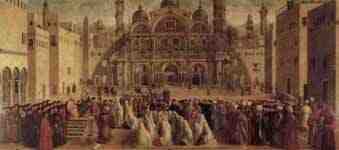
St. Marcus preaching in Alexandria
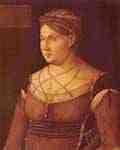
Portrait of Caterina Cornaro, Queen of Cyprus
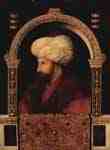
Portrait of Sultan Mehmed II Fatih
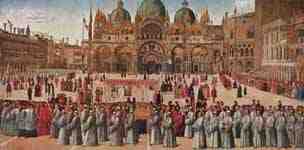
Procession in Piazza San Marco
Drawings
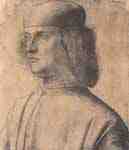
Fine Art Prints | Greeting Cards | Phone Cases | Lifestyle | Face Masks | Men's , Women' Apparel | Home Decor | jigsaw puzzles | Notebooks | Tapestries | ...
The Virgin and Child Enthroned
Gentile Bellini (c. 1429 – February 23, 1507) was an Italian painter. From 1474 he was the official portrait artist for the Doges of Venice.
Biography
Gentile was born into a family of renowned painters: his father Jacopo Bellini, was a Venetian pioneer in the use of oil paint as an artistic medium; his acclaimed brother was Giovanni Bellini, and his brother-in-law Andrea Mantegna. He was christened Gentile after Jacopo's master, Gentile da Fabriano.[1] Gentile was taught painting in the workshop of his father. Although today Gentile is often seen in the shadow of his more famous family members, in his own time he was considered among the greatest living painters in Venice and had no shortage of commissions; his talent as a portraitist revealed itself at an early age.
Paintings
Doge Giovanni Mocenigo, c. 1478; Tempera on panel; Museo Correr, Venice.
Gentile's earliest signed work is The Blessed Lorenzo Giustinian (1445), one of the oldest surviving oil paintings in Venice (now at the Accademia Museum). During the 1450s Bellini worked on a commission for the Scuola Grande di San Marco and painted in conjunction with his brother, Giovanni Bellini. From 1454 he was also the official portrait artist for the Doges of Venice,[2] (for example, see image of the Doge Giovanni Mocenigo at right).
Much of Gentile Bellini’s surviving work consists of very large paintings for public buildings, including those for the Scuola Grande di San Giovanni Evangelista. Along with Lazzaro Bastiani, Vittore Carpaccio, Giovanni Mansueti and Benedetto Rusconi, Bellini was one of the artists of hired to paint the 10-painting narrative cycle known as The Miracles of the Relic of the Cross. The commission was intended to celebrate the relic of the Holy Cross which the confraternity had received in 1369. Gentile's contributions include the Procession of the True Cross in Piazza San Marco, which dates from 1496, and the Miracle of the True Cross at the S. Lorenzo Bridge, dating from 1500 and featuring Gentile's self-portrait and that of his brother Giovanni.
Procession of the True Cross in Piazza San Marco, 1496; Tempera & oil on canvas; Accademia, Venice.
Bellini and the East
Sultan Mehmed II, 1480; oil on canvas; National Gallery, London.
Venice was, at that time, a very important point in which cultures and trade bordered on the eastern Mediterranean Sea and provided gateways to Asia and Africa. As noted, in his lifetime, Gentile was the most prestigious painter in Venice. Therefore in 1479, he was chosen by the government of Venice to work for Sultan Mehmed II in Constantinople. However in addition to his work at the Ottoman Court, Gentile's work also responded to other aspects of the East, including the Byzantine Empire.
Constantinople
Gentile Bellini's Madonna and Child Enthroned, late 15th century. Note the Islamic prayer rug at the feet of the Virgin Mary, an example of Oriental carpets in Renaissance painting.
In September 1479 Gentile was sent by the Venetian Senate to the new Ottoman capital Constantinople as part of the peace settlement between Venice and the Turks. His role was not only as a visiting painter in an exotic locale, but also as a cultural ambassador for Venice.[3] This was important to Mehmed II, as he was particularly interested in the art and culture of Italy, and he attempted on several occasions to have himself portrayed by Italian artists. He finally reached his goal with Gentile,[4] who is believed to have painted the portrait of Mehmed II now in the National Gallery, London, (but largely overpainted). It has been noticed that the portrait is like one of the figures in a painting by Marco Palmezzano, Jesus among the Doctors in the Temple (Brisighella, near Forlì and Ravenna). So the dating and authorship of the portrait by Bellini have been placed in question.[5]
Subsequently an Oriental flavour appears in several of his paintings, including the portrait of a Turkish artist and St. Mark Preaching at Alexandria (above). The last was completed by his brother, Giovanni Bellini.[6]
Greece
Queen Caterina Cornaro, c. 1500; Szépmüvészeti Múzeum, Budapest.
Gentile responded to other aspects of the East, including the Byzantine Greek Empire,[4] as well as Venice’s other trading partners in North Africa and Levant. Venice had a long-established relationship with the Eastern Mediterranean. Saint Mark, Venice’s patron, was from the Egyptian city of Alexandria, and Venice’s cultural and spiritual centre – the basilica of San Marco – was built in his honor (and as his mausoleum) in the Greek Byzantine style. Although Constantinople fell to the Ottoman Turks in 1453, the Greek Byzantine world had a continuing impact upon Venetian art and culture as a number of Greek Christians fled Muslim rule. It was here that Gentile painted the portrait of Queen Caterina Cornaro of Cyprus (at right). This is counted as the second known portrait including the queen, which is now in the collection of the Szepmuveszeti Museum in Budapest.[4]
Retirement years and legacy
Bellini's most important paintings, the monumental canvases in the Doge’s Palace in Venice, were destroyed by fire in 1577. Only a few of his other works remain, namely the large narrative paintings The Procession in Piazza San Marco (above left) and The Preaching of Saint Mark in Alexandria (above right), produced in his final years. Little remains of Gentile’s art from the 1470s and 1480s, except for the works made in Constantinople. Moreover, many workshop paintings and drawings have been assigned to Gentile Bellini. This has had the unfortunate consequence of confirming his reputation as an awkward artist, especially in comparison with his beloved brother Giovanni. Gentile's fall from popular favor seems to have begun shortly after his death; by 1557 Lodovico Dolce made a rather acerbic comment about him as an early teacher of Titian:
Titian could not bear to follow the dry and labored manner of Gentile... Because of this, leaving this awkward Gentile, Titian attached himself to Giovanni Bellini: but his style did not entirely please him either, and he sought out Giorgione.[7]
He was interred in the Basilica di San Giovanni e Paolo, a traditional burial place of the doges.
In recent years, Gentile has once again generated interest, especially in a recent spate of scholarly publications and exhibitions on the subject of cross-cultural exchange between Europe and the Levant.[8]
Selected works
Madonna Enthroned with Child (1475–1485) - National Gallery, London
Portrait of Doge Giovanni Mocenigo (1478–1485) - Museo Correr, Venice[9]
Procession in St. Mark's Square (1496) - Gallerie dell'Accademia, Venice
Miracle of the True Cross at the Bridge of S. Lorenzo (1500) - Gallerie dell'Accademia, Venice
Miracle of the Reliquary of the Cross (1500)
St. Mark Preaching in Alexandria (1504–1507) - Pinacoteca di Brera, Milan
Man with a Pair of Dividers
St. Dominic
Mehmet the Conqueror
Portrait of Caterina Cornaro, Queen of Cyprus - Szépmüvészeti Múzeum, Budapest
References
"Italian Culture and History". Boglewood.com. Retrieved 2013-09-17.
MSN Encarta : Online Encyclopedia, Dictionary, Atlas, and Homework. Archived from the original on 2009-10-31.
tr:Resim:Sarayi Album 10a.jpg
"Contemporary Art - Artist Portfolios - Art News". absolutearts.com. Retrieved 2013-09-17.
"The Sultan Mehmet II". Nationalgallery.org.uk. Retrieved 2013-09-17.
Chisholm, Hugh, ed. (1911). "Bellini". Encyclopædia Britannica 3 (11th ed.). Cambridge University Press.
Dolce, quoted in Alan Chong, "Gentile Bellini in Istanbul: Myths and Misunderstandings," in Bellini and the East (London: National Gallery Company, 2005), p. 106.
See also Venice and the Islamic World (New York: Metropolitan Museum, 2007).
A repetition from Bellini's workshop that belonged to William Beckford is in the Frick Collection, New York.
----
Fine Art Prints | Greeting Cards | Phone Cases | Lifestyle | Face Masks | Men's , Women' Apparel | Home Decor | jigsaw puzzles | Notebooks | Tapestries | ...
----
Artist
A - B - C - D - E - F - G - H - I - J - K - L - M - N - O - P - Q - R - S - T - U - V - W - X - Y - Z



